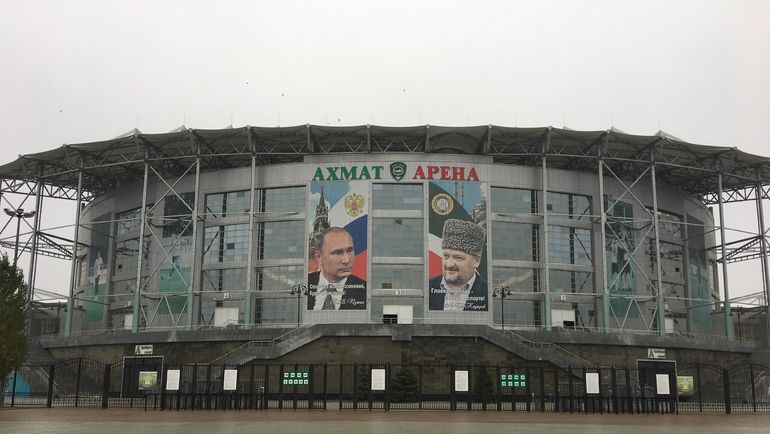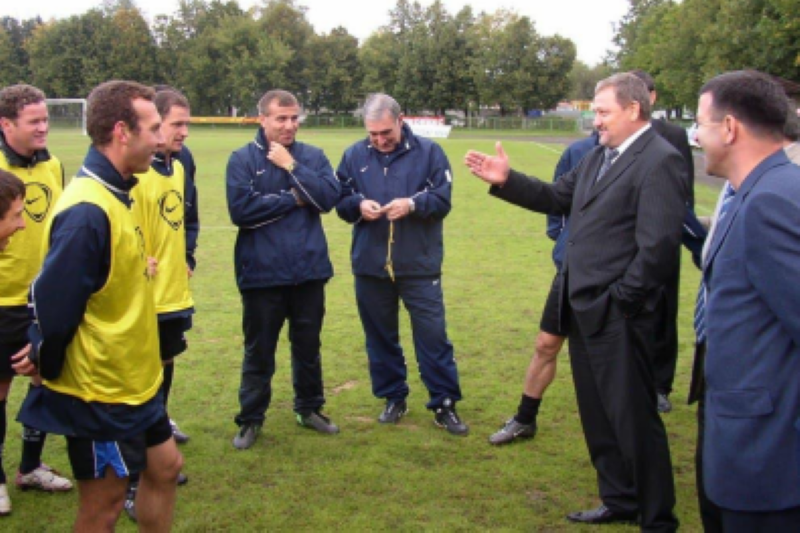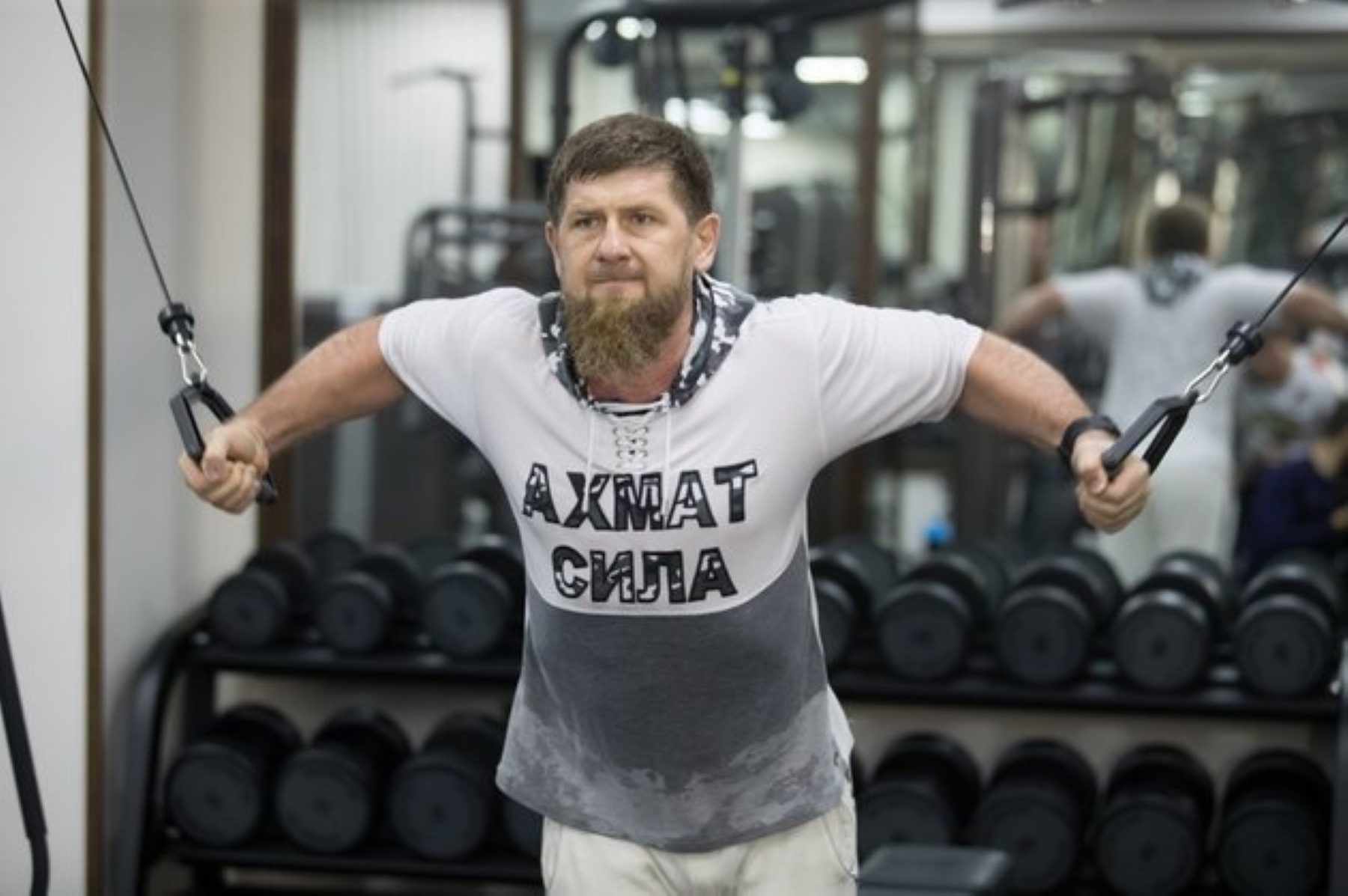Analysis | How Kadyrov uses ‘the Path of Akhmat’ in sports to cement his rule in Chechnya

In Chechnya, sport is distinctly political. Whether rubbing shoulders with athletes or sending his sons out into the ring, Head of Chechnya Ramzan Kadyrov uses training and competitive sports to bolster his public image, construct a national identity that suits his aims, and secure the future of his regime.
UFC280 fight night was a hotly anticipated event amongst mixed martial arts (MMA) enthusiasts in the Caucasus. The night, organised by the world’s largest MMA promotion company, was headlined by a fight between Daghestani Islam Makhachev and Brazilian Charles Oliveira. The event was a triumph for the Caucasus, as Makhachev beat Oliveira to become the new champion of the UFC lightweight division.
But the fight itself was not the only entertainment of the evening. Long-running animosity between two North Caucasus republics sparked off immediately after the main event, as Khamzat Chimayev, a popular Chechen-Swedish mixed martial artist, got into a cage-side scuffle with Daghestani welterweight Abubakar Nurmagomedov, cousin of UFC star Khabib Nurmagomedov.
By the following day, the conflict appeared to have been resolved: Head of Chechnya Ramzan Kadyrov posted a screenshot of himself in a video call with both Chimayev and Nurmagomedov.
‘There is no problem between Khamzat Chimayev and Abubakar Nurmagomedov, I have made sure of it personally’, read the caption.
This is far from the first time that Kadyrov has involved himself in the affairs of Caucasian sportspeople. He attaches great importance to developing sports within his republic, and personally ensures that talented Chechen athletes are promoted both nationally and internationally.
Kadyrov claims that these athletes, who often appear alongside him in photographs and at public events, serve as role models for young Caucasian people. However, he also uses sportspeople and sports to promote a Kadyrov-centric vision of Chechen identity, bolster his image domestically and internationally, and pave the way for his children to continue in his footsteps.
Pursuing ‘the path of Akhmat’
It is impossible to walk 100 metres in Grozny without seeing a reference to Akhmat Kadyrov, the first president of the Russian Republic of Chechnya and father of Ramzan Kadyrov. Streets, schools, stadiums, and even the airport all bear his name.

In some streets, photographs of a bomb-ravaged Grozny in the 2000s, destroyed in the conflict between Russia and the Chechen Republic of Ichkeria during the Second Chechen War, are on display to remind Chechens of their recent history. But the main purpose of those images is not maintaining collective memory: it is promoting an ideology and a particular version of history.
Ramzan Kadyrov wants Chechens to be grateful to his father, Akhmat Kadyrov, who according to him, brought peace to their republic.
The first step in achieving this so-called ‘peace’ was Chechenisation: in June 2000, Russian President Vladimir Putin entrusted the management of the conflict to Chechens loyal to Moscow. Akhmat Kadyrov switched sides and became the head of this new alliance.
The goal of this Chechenisation of the conflict, was, according to sociologists Le Huérou and Merlin, ‘to ensure the reintegration and the anchoring of the republic within the Russian Federation, after two wars of extreme violence ’.
In 2004, Akhmat Kadyrov was killed in a bomb attack. His son, Ramzan Kadyrov, became president in 2007, and immediately began the process of mythifying his father.
Official Chechen histories describe Akhmat Kadyrov as a hero of the Chechen nation. This narrative is heavily promoted, with Ramzan Kadyrov declaring on what would have been his father’s 71st birthday this year, that Akhmat Kadyrov had ‘saved his people from destruction [and] Russia from collapse’.
‘Everything that is done today in the Chechen Republic is as it was decreed by Akhmat-Khadzhi, his forecasts, his dreams. Following the course that he showed us, we rebuilt the cities and villages destroyed during the war years practically from their foundations’, he said.
This idea of Akhmat Kadyrov as the saviour and leader of Chechnya is encapsulated in the phrase ‘the path of Akhmat’, frequently used by Kadyrov to describe the ‘peaceful’ route the republic has followed since his father became president.
More than just an expression, ‘the path of Akhmat’ is an authoritarian ideology, aimed at controlling every aspect of the life of a Chechen: work, history, culture, and also sports.
Sports at the service of an ideology
On the official website of Chechnya’s Ministry of Physical Culture, Sports, and Youth Policy, the second page was long dedicated in its entirety to Akhmat Kadyrov. It told the story of sports in Chechnya, making clear the inextricable connection to the republic’s former president.
‘Akhmat-Khadzhi Kadyrov showed great concern for the revival and development of physical culture and sports in the Chechen Republic […] In the mid-2000s, A-K Kadyrov proclaimed that in the transition from war to peaceful life, one of the main roles was to be played by sports’.

Ramzan Kadyrov uses such history in endeavours to build a Chechen national identity that suits his aims. This ‘nation-building’ has two aims: unifying the state and its people around an official history and ideology, and developing a strong sense of national identity, and so ensuring political stability.
In Kadyrov’s Chechnya, Akhmat is supposed to unify the republic, and so is presented at the heart of every success. Every new public utility project is associated with a quote from Akhmat Kadyrov, to make clear that Ramzan Kadyrov is following his father’s path and finishing the job he started.
For example, on visiting any museum or cultural centre in Chechnya, the visitor is greeted by the quote ‘Without culture, there is no nation’. This reminds the visitor that Akhmat Kadyrov considered ‘the main factor in the successful revival of the republic to be raising the level of culture’, as declaimed in the republic’s official histories.
And sports are central to this dynastic propaganda. Identifying sportsmen linked to Kadyrov isn’t a hard task. He has established codes and slogans specific to his regime, with Chechen sportsmen using the phrase ‘Akhmat Sila’ (literally, ‘Akhmat is power’) to show that they too are following ‘the path of Akhmat’.
This slogan echoes within the republic and outside of it, used by Kadyrov’s family members, government officials, Kadyrov’s soldiers in Ukraine, and in every Chechen propaganda clip. Since 2017, many sports clubs and organisations have been renamed ‘Akhmat’, including FC Akhmat Grozny and Absolute Championship Akhmat (ACA), as part of a broader campaign of Kadyrovisation of Chechnya.
[Read more on OC Media: FC Terek Grozny renamed ‘Akhmat’]
Sports and sportspeople as propaganda tools
One of the best ways to understand Kadyrov’s political strategies, ambitions, and nation-building tools is to analyse his social media accounts, particularly Instagram and Telegram.
Karena Avedissian, a political scientist, considers Instagram a tool used by Kadyrov for the construction of official Chechen memory, and notes that Kadyrov’s Instagram has three main themes: religion, sports, and public relations. Since the beginning of Russia’s invasion of Ukraine, war has become another dominant theme in his social posting.
On social media, Ramzan Kadyrov uses sports to build legitimacy around the world by promoting Chechen fighters, combat sports, and a healthy lifestyle through exercise.
Many of his Instagram posts show the Head of Chechnya training at the gym, allowing him to suggest that he’s not just a political statesman who rubs shoulders with great athletes; he himself is charismatic, aspirational, and perhaps even relatable. He practices what he preaches, embodying the lifestyle he promotes, and so strives to create a relationship with other followers of that lifestyle.
In one of his gym posts, he mentions that he had done ‘a a great job on the cardio strength exercises’, and claimed he had been accompanied by the Minister of Physical Education and Sports.
‘Everyone left the gym in a good mood! Play sports, friends, develop yourself, work hard and you will be healthy!’

In sharing videos and images of himself training, Kadyrov is pursuing two main aims: nation-building, by encouraging Chechen men to aspire to the ideal of virility that he wants to represent, and nation-branding and sportswashing by projecting an image of a man in good health, strong and close to his people, and so offering an alternative image of Kadyrov to the West.
Continuing the family line
This passion for combat sports isn’t just about Ramzan Kadyrov himself. Year after year, month after month, his three sons are also increasingly on display in propaganda videos.
According to journalist Karim Zidan, Kadyrov uses sports and MMA for dynastic propaganda purposes, to demonstrate the cross-generational fitness of the Kadyrovs, and so secure his bloodline and present his clan as legitimate to rule Chechnya.
Kadyrov wants to make clear that his sons are strong fighters: brave, combat-ready, fiercely patriotic, and generally ready to be great Chechen leaders.
Before the Russian invasion of Ukraine, Kadyrov had had limited opportunity to present his sons as fighters, as being a warrior was still closely associated with Islamic extremism. Combat sports were a way to show that his sons were strong and able to fight, so footage of his sons boxing and practising MMA with popular sportspeople made frequent appearances on his social media channels.
He even sent his sons into fights in amateur boxing championships, wearing no protective gear, in a move that drew condemnation from sportspeople and MMA fans. The fights were, of course, consistently won by his sons, who wore vests with the face of Akhmat Kadyrov on them.
However, since Russia’s invasion of Ukraine, he has been able to outdo these previous performances, by sending his sons into what he claims is real combat. Kadyrov has shared videos and photographs of ‘the grandchildren of the First President of the Chechen Republic, Hero of Russia Akhmat-Khadzhi Kadyrov’ in combat gear and wielding rifles, allegedly from the front line.
In one post, he claimed they ‘provided covering fire for advancing fighters’, and were ‘actively searching’ for pro-independence Chechen battalions.
‘The grandchildren of Akhmat-Khadzhi stayed in their positions until they repulsed another Nazi counterattack.’
In all of these posts, Kadyrov makes clear his underlying intentions — to show that in Chechnya, power lies with the Kadyrovs, and will remain there.






